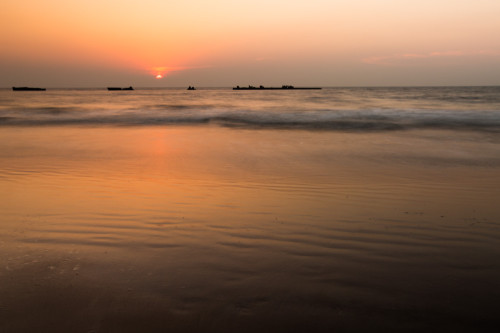
Two days back I posted this curious picture which looks like sun trail on my Facebook page and asked my friends to solve mystery how it was taken. This resulted is a flurry of answers, few were nearer to truth and few were very far fetched. All in all it was a great exercise in trying to reverse engineer a curious photograph. Here is how it all started. I had recently purchased a Singh-Ray Variable Neutral Density Filter after selling my existing Hoya ND4 & ND8 filters to my good friend. Using that filter I wanted to experiment with slow shutter speed sunset photography along sea shore. When My daughter and her friend dragged me to a beach on a Sunday I felt that is the best time to test this filter. I was at Tannirbavi beach, Mangalore where in year 2007 M V Denden ship belonging to a African country called Eritrea sank just 300 meters away from the coast. You can see the remnants of that ship in these pictures.

The Vari-ND is capable of densities of more than 8 stops. Using the filter at its most extreme densities may produce a noticeable “crossbar” effect or slight color shifts. Best results are obtained within its nominal range of 2 to 6 exposure stops. Even stopping 6 Stops it is not enough in most of the situation when the light is harsh. I have noticed my 5D mark III produces a very soft and mushy type picture beyond f/16 due to diffraction. So my smallest aperture cannot go beyond f/16. Lowest ISO I can use is ISO 50. Here again I am not sure how ISO 50 is better than IS O100 which is the native ISO of my camera. DxOMark test of the sensor shows clearly that ISO “50” and “100” have the same sensitivity, which means that “50” is just a software order given to the program that process the RAW file. (http://www.dxomark.com/index.php/Cameras/Camera-Sensor-Database/Canon/EOS-5D-Mark-III). This left us a very limited slow shutter speed time of 2-4 sec when the sun was up. I was expecting a very long shutter speed of few minutes and was thoroughly disappointed that I could not get. Canon EF 16-35mm f/2.8 L USM Lens on Canon EOS 5D Mark III worked well but sharpness at the extreme wide angle of 16mm was not very great. So I limited to 21mm focal length which was wide enough and produced a great sharpness. I had camera on a tripod throughout, used a shutter release to avoid vibration.

To overcome my disappointment of not get extremely long shutter speedsI tried few experiments with this limited long exposure. One experiment I tried was to use hyper-focal length to maximize the focus from foreground to background. You can see in the above picture the starfish at the foreground is also in focus as the sunken ship. At that small aperture the depth of field is quite large. I focused one third into the field mainly on the star fish I got focus till infinity in the back and quite a bit of sand in front of the starfish. You can check more about hyper focal distance and its use here in my article Hyperfocal Distance

I also tried zoom effect along with long exposure. A zoom effect in photography terms is where you capture an image which looks like the subject is moving either towards you or away from you with a motion kind of lines. It’s also known as racking the lens. I tried zooming out first starting from 16mm then moving all the way to 35mm when the shutter was open. It worked well but was not so great as my zooming had resulted see to swell up and cover all the sun and was looking unnatural. See the results here above what happens if I do the slow zooming out throughout the 2 second exposure. Everything including the sea is uniformly blurred as zoom burst effect or popularly just called zoom effect. If you like to learn more about zoom effect check this link – Mastering the Zoom Effect

Once I saw the sun trail in the Zoom effect I wanted to replicate without the blurred sea effect. I tried zooming in, it was also not very impressive. After few trial and errors I found out the trick is to zoom in very fast just at the start of the click of shutter from 35mm to 21mm and then leave camera to record for the rest 2 secs. This results in the first photograph which almost looked like a sun trail without significance disturbance to the seascape. The principle behind this is simple. Sun is bright source and will expose pretty fast, sea on the other hand is reflecting his light and is weaker light source. As I was zooming in sun has already burnt his trail and when I left for the last 1.5 of the 2 secs exposure the sea etched its exposure on the sensor. So in effect it looked as though sea was stationary and only sun had moved a greater distance in such a short time. This is how I faked Sun Trail here.

Real Sun trail needs AstroSolar filters Which are ND 5.0 strength (which means they stop 16-17 stops of light) and can be fitted on the lens and you can directly observe the sun without loosing your sensor or eye sight. These are also used during solar eclipse photography. Using those we can take star Trails like these . In The NASA Photo a very dark filter covered the camera lens for most of the time, allowing only a trifle of light from the bright Sun to peek through. Just after the Sun had dipped below the horizon but before it was completely dark, the thick filter was removed and the pretty foreground scene was captured. Slight flares appeared when the Sun went behind thin clouds.

Now I am planning to buy a 9-10 stop filter and try to stack that with my Variable Neutral Density Filter and achieve a far longer shutter speed. It was a good experiment to test everyone’s skill in trying to reverse engineer such technique. I feel at least I made you think about a photograph. I thank all my friends who participated and gave their valuable suggestions trying to solve this puzzle.
“The important thing is not to stop questioning. Curiosity has its own reason for existing.” – Albert Einstein


Thanks a lot sir. It’s really very very helpful
Wow! thanks for a detailed explanation on the lens and experiment.
Thank you Micheal
Thank you Doc for detailed explanation on this particular Filter… my knowledge on filters is “Zero” 🙁 need to learn more about them and their use and effects it has on our images.